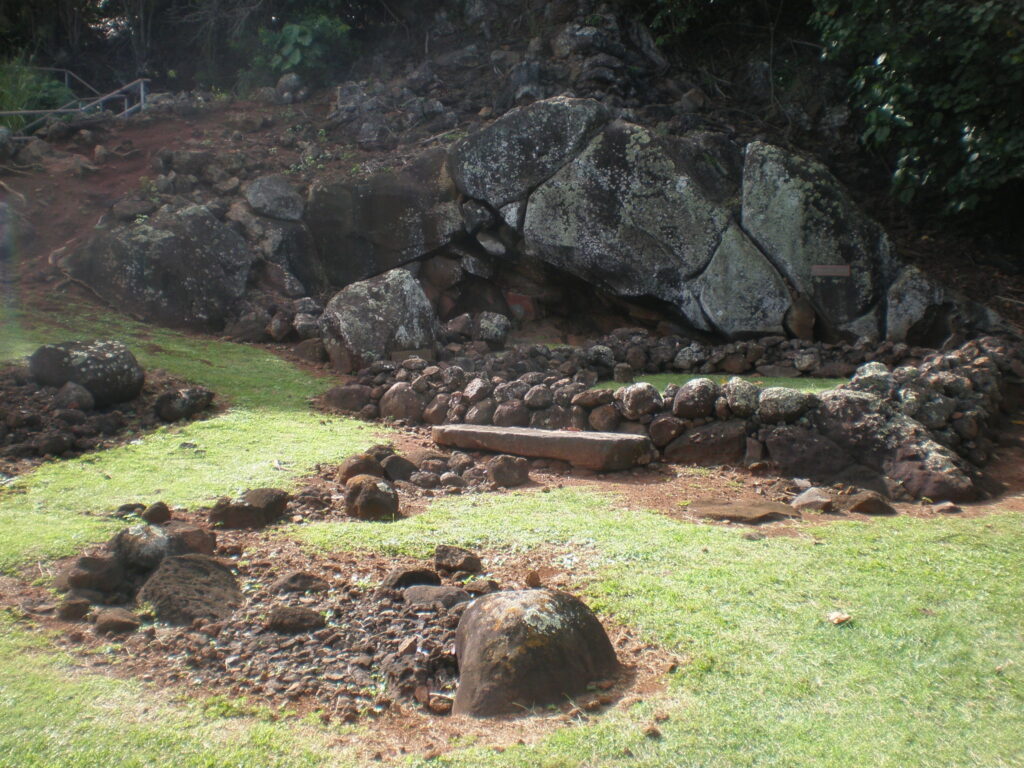Early on, with the family unit being the socio-political structure, there was no need for a hierarchical or complex society. However, as the population increased and wants and needs increased in variety and complexity, the need for chiefly rule became apparent.
Eventually, a highly stratified society evolved consisting of the Ali‘i (ruling class,) Kahuna (priestly and expert class of craftsmen, fishers and professionals) and Makaʻāinana (commoner class.)
The concept of private ownership of property did not exist in Hawaiʻi. The Kings were the sovereign owners of all of the land which was in turn controlled by the aliʻi nui or high chiefs and tended or farmed by the kanaka or commoners. (RE3)
Laws and rules, called kapu, were created to prohibit abuse of resources, both to the land and ocean. The kapu prohibited certain practices in order to preserve scarce or limited resources. In this system everyone was entitled to a share of what was produced from the soil or taken from the sea. (RE3)
Over the centuries, the Islands weren’t unified under single rule. Leadership sometimes covered portions of an island, sometimes covered a whole island or groups of islands. Island rulers, Aliʻi or Mōʻī, typically ascended to power through warfare and familial succession.
At the period of Captain Cook’s arrival (1778-1779), the Hawaiian Islands were divided into four kingdoms: (1) the island of Hawaiʻi under the rule of Kalaniʻōpuʻu, who also had possession of the Hāna district of east Maui; (2) Maui (except the Hāna district,) Molokaʻi, Lānaʻi and Kahoʻolawe, ruled by Kahekili; (3) Oʻahu, under the rule of Kahahana; and at (4) Kauaʻi and Niʻihau, Kamakahelei was ruler.
There were family connections of these four to Kamehameha; the death of Kiwalaʻo; the “Four Kona Uncles” (Keʻeaumoku, Keaweaheulu, Kameʻeiamoku and Kamanawa (the last two are twins and are depicted on the Hawaiian Coat of Arms;)) permission from Kalola to marry her granddaughter (after the defeat of Maui) and how Kamehameha secured his “unification” by “sharing the spoils” of the conquests and “braided the bloodlines;” eventually leading to the agreement with Kaumualiʻi. (Yardley)
In Hawaiʻi, as in other parts of the world, control of the ʻāina has long been recognized as the basis for sovereignty. This was especially true in traditional Hawaiian society before Kamehameha united the islands. At that time, the ultimate control of all ʻāina was vested in the mō’ī of each island, as he or she was the paramount Chief. (Kameʻeleihiwa)
Control of ʻāina is not the same as ownership of ʻāina, in the Western capitalist sense. In traditional Hawaiian society, ʻāina was given from one person to another, but was never bought or sold.
If in Hawaiian metaphor, all ʻāina and products of the ʻāina – in fact life itself – proceed from the Akua, then “ownership” of the ʻāina and all wealth emanating from the ʻāina rightfully belong to those Akua from whom they proceed. (Kameʻeleihiwa)
Kālaiʻāina (the carving/distribution of land) by the mōʻī was practiced not only upon conquest, but traditionally at the peaceful ascension of a new mōʻī. (Klieger)
After selecting lands for himself, the King allotted the remaining to the warrior Chiefs who rendered assistance in his conquest. These warrior Chiefs, after retaining a portion for themselves, reallotted the remaining lands to their followers and supporters.
However, no one owned the land and at death a parcel or unit was returned to the overseer for redistribution. Essentially, the king could distribute land to anyone he wanted if he so chose. (RE3)
The distribution of lands was all on a revocable basis. What the superior gave, he was able to take away at his pleasure. This ancient tenure was in nature feudal, although the tenants were not serfs tied to the soil – they were allowed to move freely from the land of one Chief to that of another.
A process for formal individual “ownership” of the land followed a transition over the years. In 1839 the Bill of Rights of the Hawaiian Islands was enacted which guaranteed that people’s lands would not be taken from them.
In 1840, the first Constitution of Hawai`i was enacted. This constitution made it clear that people had an interest in land greater than that of the bounty and produce of the land.
In 1845, the Land Commission was created in Hawaiʻi by Kamehameha III to award land claims. Then, in 1848, the Māhele (land division) occurred with the King and 245 aliʻi and konohiki came together to divide the land.
Each māhele was in effect a quitclaim agreement between the King and a Chief or Konohiki with reference to the lands in which they both claimed interests. For the lands set aside for the Chief or Konohiki, the King signed an agreement: “I hereby agree that this division is good. The lands above written are for (name of Chief or Konohiki); consent is given to take it before the Board of Commissioners to Quiet Land Titles.”
The Māhele itself did not convey title to land. The high Chiefs and the lesser Konohiki were required to present their claims before the Land Commission to receive awards for the lands. With an award, the person was still required to pay commutation to the government, in cash or by surrender of equally valuable lands (set at one third of the value of the unimproved land.)
In the Māhele of 1848, of the approximate 10,000 awards, around 1,000,000-acres were reserved by King Kamehameha III as “Crown” lands, 1,500,000-acres were given by the King (as “Government” lands) to the ‘government and people’, approximately 1,500,000-acres were set aside for the Chiefs (as “Konohiki” lands) and less than 30,000-acres of land were awarded to the native tenants (Kuleana lands.)















